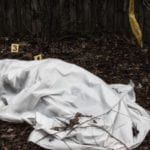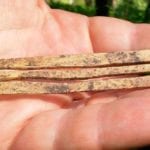 Mysteries
Mysteries  Mysteries
Mysteries  History
History 10 Surprising Stories About the Texas Rangers
 Humans
Humans 10 Philosophers Who Were Driven Mad by Their Own Theories
 Miscellaneous
Miscellaneous 10 Video-Game-Worthy Weapons and Armors from History
 Weird Stuff
Weird Stuff 10 Psychics Who Accurately Predicted Wartime Events
 The Arts
The Arts 10 Pieces of Art Inspired by a Broken Heart
 Health
Health 10 Science Fiction-Sounding New Medical Treatments
 History
History 10 Surprising Facts About the Father of Submarine Warfare
 Space
Space Ten Astonishing New Insights into Alien Worlds
 Weird Stuff
Weird Stuff 10 Bizarre Summer Solstice Rituals Still Practiced Today
 Mysteries
Mysteries Top 10 Haunting Facts About the Ghost Ship MV Alta
 History
History 10 Surprising Stories About the Texas Rangers
 Humans
Humans 10 Philosophers Who Were Driven Mad by Their Own Theories
Who's Behind Listverse?

Jamie Frater
Head Editor
Jamie founded Listverse due to an insatiable desire to share fascinating, obscure, and bizarre facts. He has been a guest speaker on numerous national radio and television stations and is a five time published author.
More About Us Miscellaneous
Miscellaneous 10 Video-Game-Worthy Weapons and Armors from History
 Weird Stuff
Weird Stuff 10 Psychics Who Accurately Predicted Wartime Events
 The Arts
The Arts 10 Pieces of Art Inspired by a Broken Heart
 Health
Health 10 Science Fiction-Sounding New Medical Treatments
 History
History 10 Surprising Facts About the Father of Submarine Warfare
 Space
Space Ten Astonishing New Insights into Alien Worlds
 Weird Stuff
Weird Stuff 10 Bizarre Summer Solstice Rituals Still Practiced Today
10 Forgotten Artifacts That Have Been Rediscovered
Over the years, many artifacts with cultural, historical, and archaeological significance have been lost. What’s surprising, though, is that many of these valuable objects were not really lost but simply forgotten. Either caused by human error or plain carelessness, a number of remarkable relics have remained hidden from the eyes of the public for decades or even centuries. Thankfully, many of these valuable artifacts eventually get rediscovered, often by accident.
10A Neolithic Figurine
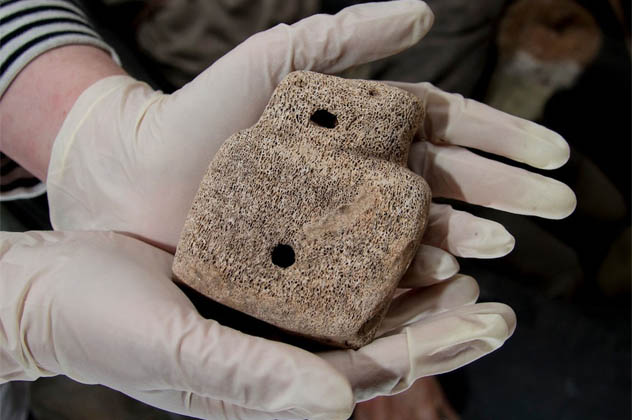
In the 1850s, a mysterious Neolithic figurine was discovered in Skara Brae, a UNESCO World Heritage Site located on Orkney Island at the northern tip of Scotland. Experts estimate the artifact to be around 5,000 years old. It was carved from a whalebone and measures 9.5 centimeters (3.7 in) high and 7.5 centimeters (3 in) wide. What makes this figurine interesting is that it’s one of the region’s oldest known statues depicting a person.
Dubbed “Buddo,” which means “friend” in the Orkney language, this artifact had been missing for more than 150 years. Buddo was stored in the archives of the Stromness Museum and then simply forgotten. It was only when archaeologists decided to review the artifacts from Skara Brae that Buddo was rediscovered.
At the time of its discovery, Buddo was the oldest human depiction ever found in that area. Experts aren’t sure what it is, but they think it might be a Neolithic idol or a ritualistic item left behind when the villagers moved to a different region.
9First-Edition Copy Of The Map That Changed The World
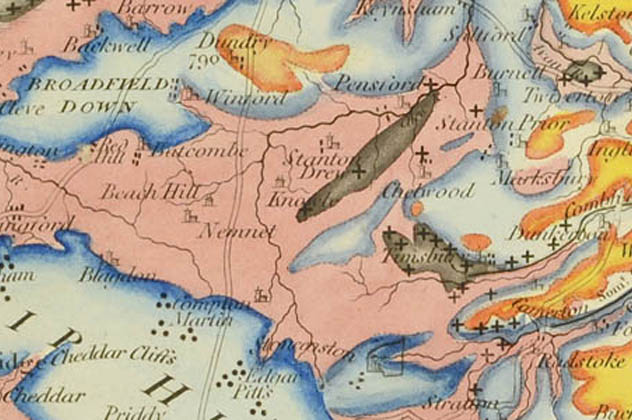
In the world of geology, William Smith is a legend. He is considered to be the “Father of English Geology” and the maker of the “map that changed the world.” Smith was the first person to create a geological map of a country. Specifically, Great Britain. During the time of its publication, Smith’s map was revolutionary. It was the first of its kind, influencing the future development of geological maps.
Records indicate that 370 copies of Smith’s geological map were produced, but only 70 exist to date. Just like Buddo, the map was stored in a safe place and then simply forgotten. The last time it was seen was between 40 and 50 years ago. It was rediscovered in the archives of the Geological Society, kept safe inside a leather sleeve case. In hindsight, getting lost for half a century was good for the map. It was not exposed to sunlight, and as such, it is in good condition and its colors have remained exquisite.
What makes this map special and valuable is that it is a first edition. Experts believe that the map was “certainly among the first 50 to come off the production line, and very probably among the first 10.” This information has led experts to estimate that the value of the map is in the six figures.
Today, maps like this can be easily created thanks to modern technology, but it probably took Smith close to 15 years to gather the data needed to create his.
8Oldest Surviving Cannonball In England
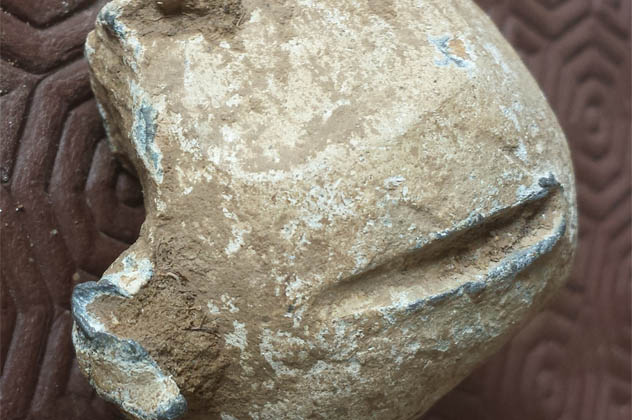
The Wars of the Roses is perhaps one of the most iconic moments in English history. The struggle involved the feuding houses of York and Lancaster in their fight over the English throne. It lasted for more than 30 years and ended when Henry Tudor of the House of Lancaster defeated Richard III at the Battle of Bosworth Field.
Several years ago, experts discovered an artifact that belonged to the historic Wars of the Roses. It was a cannonball used in the Battle of Northampton in 1460—one of the many battles in the Lancaster-York feud. Aside from fact that it was used during the Wars of the Roses, this particular artifact is highly prized for being the oldest surviving cannonball in English history. However, it got lost or perhaps simply forgotten. It was only rediscovered in 2014 by Glenn Foard, an archaeologist from the University of Huddersfield.
One of the mysteries involving this massive cannonball was who fired it. Was it the Lancastrian forces or the York soldiers? Thankfully, historical accounts have shed light upon this mystery. According to records, the Lancastrian forces were unable to use their cannons during the Battle of Northampton due to rain. As such, it can be safely assumed that it was the York soldiers who used the cannonball.
7Sculpture Of Cleopatra And Marc Antony’s Twin Babies
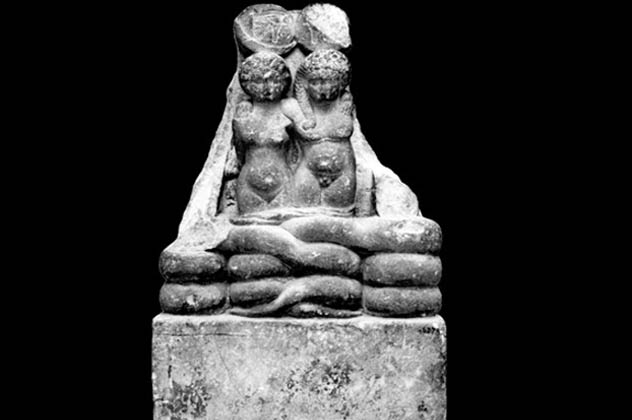
In 1918, archaeologists discovered a peculiar sandstone statue near the temple of Dendera. For decades after, the sculpture was on display in the Egyptian Museum. Visitors and museum staff would pass by the statue, not knowing its real identity and historical significance. It was only recently, when an Egyptologist named Giuseppina Capriotti examined the sculpture, that its mystery was revealed.
The sculpture depicts two naked children. One is a female while the other is a male. Both are holding a snake on one hand while the other hand is draped over the other twin’s shoulder. One eye-catching feature of this artifact are the discs sculpted on the children’s heads. They contain the udjat-eye or the eye of Horus, a common Egyptian symbol. Intriguingly, the discs are not identical. The girl has a crescent and lunar disc on her head while the boy has a Sun disc.
After conducting a thorough analysis, Capriotti discovered that the children depicted in the sculpture are Alexander Helios and Cleopatra Selene—the twin babies of Cleopatra and Marc Antony. Though the sculpture is in relatively good condition, the faces of the two children are not well preserved.
Not much is known about the twins, especially Alexander Helios, who suddenly vanished without a trace together with his younger brother, Ptolemy Philadelphus. Cleopatra Selene, on the other hand, married King Juba II of Mauretania.
6Oldest Pharaoh Carvings
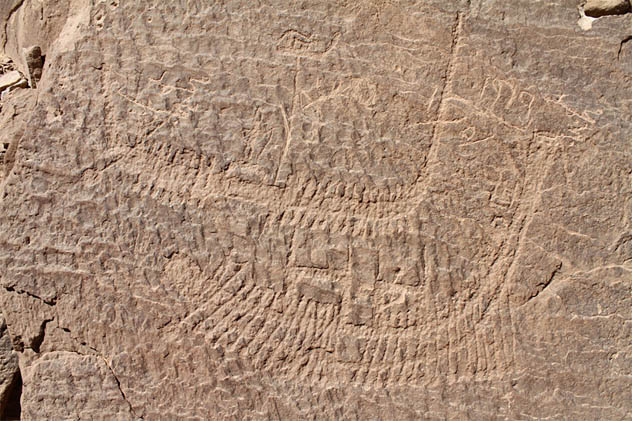
In the 1890s, archaeologist Archibald Sayce discovered a few remarkable carvings in the Egyptian village of Nag el-Hamdulab. Sadly, his discovery was not deemed important during his time and was only partially illustrated in a book. Fast forward in time, and archaeologist Labib Habachi went to the site and took pictures of the carvings. For some unknown reason, he never published them.
For years, the carvings remained forgotten. It was only in 2008, when Maria Gatto of Yale University saw Habachi’s photos, that the forgotten carvings were rediscovered.
This work of art is historically valuable since it is the oldest depiction of a pharaoh that we’ve ever found. The carvings depict a white-crowned figure traveling in “ceremonial processions and on sickle-shaped boats.” Experts theorize that what the images try to convey is a pharaoh going on a tax-collecting tour throughout Egypt.
Archaeologists estimate that the carvings were created somewhere between 3200 and 3100 BC, which is the period of time when Egypt was transitioning from two kingdoms to one. This has led experts to conclude that the pharaoh depicted in the carvings might be Narmer, who unified the two regions of Egypt.
5Murals Of Crusaders And Medieval Military Orders

Thanks to a storeroom reorganization and a burst water pipe, forgotten wall murals of Crusaders and medieval military orders were rediscovered in Saint-Louis Hospice in Jerusalem. They were painted by a French count named Comte Marie Paul Amedee de Piellat, who also built the hospital in the 1800s. He named it after St. Louis IX, a French king and a crusader.
During World War I, the Turkish forces got control of the hospital. They did not destroy the building, but they covered the walls with black paint, hiding de Piellat’s murals. When the war ended, the control of the hospital was given back to de Piellat. For several years, he worked on restoring the wall murals. Sadly, he died a few years later, unable to complete the restoration.
For almost a century, his work remained forgotten. It was only in 2014 that they were rediscovered. The nuns working in the hospital were doing some reorganization in the storerooms when they found the wall paintings. Coincidentally, a water pipe also burst, revealing several sections of the murals by stripping away plaster and modern paint.
The hospital has no plans to make the wall paintings a tourist attraction since the institution is still fully functional, catering to patients with chronic and terminal illnesses.
4World’s Oldest Complete Torah
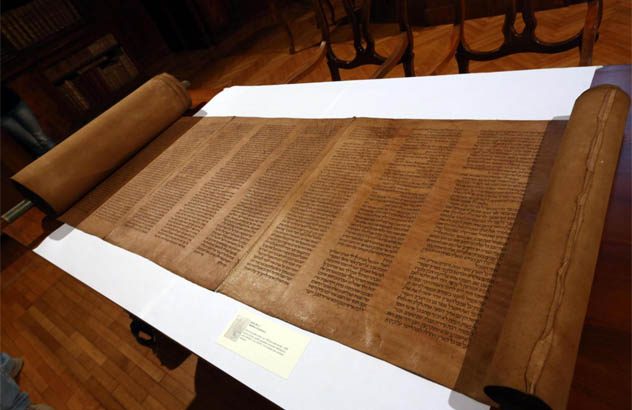
The Torah is the most important text in Judaism. As such, any discovery related to it can be considered a significant religious and historical find. In 2013, Professor Mauro Perani of Bologna University—the oldest university in the world—discovered what is considered to be the oldest copy of the Torah.
The scroll was wrongly dated by a librarian in 1889. He estimated that the text was written in the 17th century. As a result, the scroll remained ignored and forgotten in Bologna’s library for more than 100 years. It was only when Perani decided to re-examine the text that its true identity and value were unveiled.
What caught Perani’s attention was that the script used in the scroll was “from a Babylonian tradition,” suggesting that it could have not been written in the 17th century. In addition, the text had “letters and symbols that were forbidden” by Jewish scholars in later copies of the Torah. These peculiarities led Perani to consult scholars who suggested that the artifact might have been created between the 12th and 13th centuries. And the scholars were right! Carbon dating puts the creation of the scroll between 1155 and 1225.
Before the discovery of this text, the oldest known copy of the Torah was from the 14th century.
3Bear Claw Necklace From The Lewis And Clark Expedition
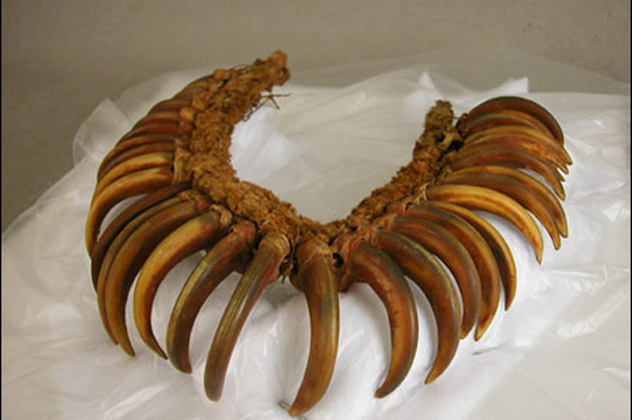
William Clark and Meriwether Lewis achieved legendary status after exploring the American West. During their expedition, they were given several Native American artifacts. One of these was a rare bear claw necklace—a piece of jewelry that signified bravery and has long been associated with warriors among many Native American tribes. The necklace consists of 38 bear claws, each one measuring approximately 7.5 centimeters (3 in). It’s in relatively good condition, although the original red color of the claws has faded.
The necklace got lost due to a staff member’s mistake. When Harvard’s Peabody Museum acquired the artifact in 1941, a staff member mistakenly cataloged it with the South Pacific islands artifacts. For decades, this valuable memento from the Lewis and Clark expedition remained forgotten. It was only in December 2003 that the historical artifact was rediscovered after two collection assistants working in the Oceania storage rooms realized that the necklace they were documenting did not really look “Oceanic.”
2Noah’s Skeleton
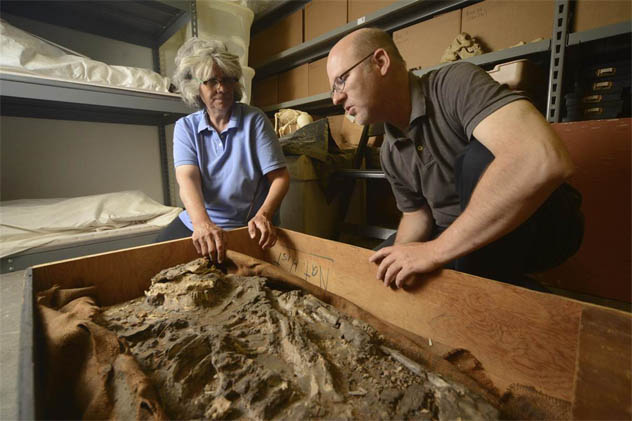
After more than eight decades, Noah’s skeleton was finally rediscovered. Unfortunately, this is not the same Noah mentioned in the Bible. However, the two shared a common experience. The skeleton, which archaeologists estimate to be around 6,500 years old, was given the name Noah after experts discovered that he survived a massive flood—just like the Biblical Noah.
The skeleton, dating back to roughly 4500 BC, was discovered by a joint expedition by the British Museum and the Penn Museum of the University of Pennsylvania. It was unearthed in the Royal Cemetery of Ur (modern-day Iraq) by Sir Leonard Woolley. Not much is known about Noah, but after conducting an analysis, Woolley postulated that he was a well-muscled man with a height of 178 centimeters (5′ 10″) and that he died at the age of 50.
For more than 80 years, Noah’s skeleton remained hidden in the basement of Penn Museum. It was only in 2014, when the museum decided to digitize all records pertaining to the joint expedition of the British Museum and the Penn Museum between 1922 and 1934, that the skeleton was rediscovered.
The rediscovery of Noah is significant since human remains during his era are extremely rare, and with new scientific techniques, experts can potentially learn a lot about the diet and lifestyle of people from Noah’s time period.
1Isaac Newton’s Recipe For The Philosopher’s Stone
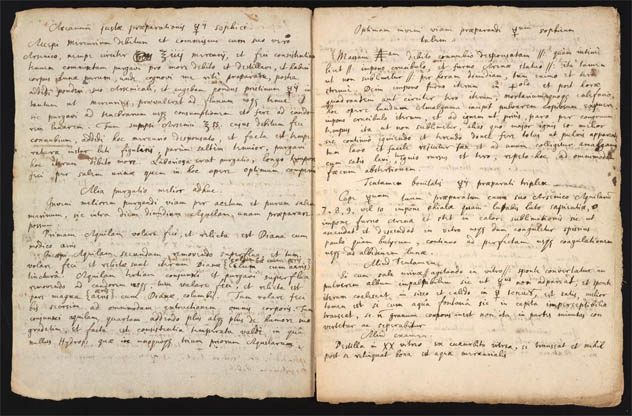
It is a widely known fact that Isaac Newton is a legendary physicist. But what many people do not know is that he also dabbled in alchemy. In fact, Newton tried unsuccessfully to transform lead into gold for years.
Just recently, experts rediscovered a recipe that Newton might have used to create the philosopher’s stone—a fabled object capable of turning any base metal, such as lead, into a valuable one, such as gold. What makes this recipe remarkable is that it was handwritten by the legendary physicist himself.
For decades, the recipe was held by a private collector. It was only in 2016 that it was rediscovered and unveiled to the public. The valuable manuscript was bought by a Pennsylvania-based nonprofit called Chemical Heritage Foundation, which is working on uploading the images and transcriptions of the recipe to the Internet so that the public can view it.
Newton’s recipe for creating the philosopher’s stone would have not been lost and forgotten had his own Alma Mater, Cambridge University, decided to archive it in 1888. Back then, Cambridge University declined the opportunity to store any of Newton’s works that involved alchemy.
Paul Jongko is a freelance writer who spends his time writing interesting stuff and managing MeBook. When not busy working, Paul creates piano covers, masters his capoeira skills, and does progressive calisthenics training. Follow him on Twitter.






